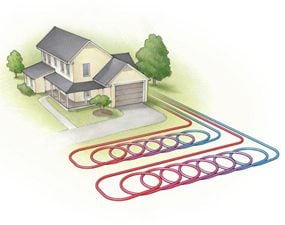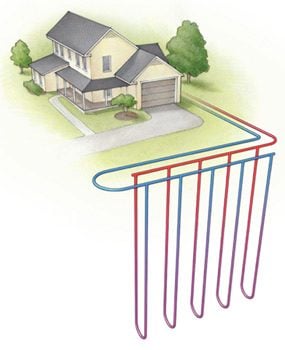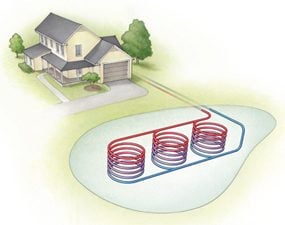Heat pumps are some of the most energy efficient heating systems available today. They’re also eco-friendly HVAC options because they don’t burn gas or oil to operation and they use far less electricity than other systems. The main downside is that they can be expensive to install, but with significant rebates and tax incentives available, combined with the cost savings they offer over the years, it’s an increasing popular option for homes.
What Is a Geothermal Heat Pump?
A geothermal heat pump draws heat from the ground and releases it in your home. They’re vastly more efficient than conventional heating systems because a heat pump doesn’t burn fuel to create warmth; it simply moves existing heat from one place to another. And because temperatures underground remain a relatively constant 50 degrees F year round, the system requires a lot less energy to cool your home than conventional air conditioning systems or air-source heat pumps, which use outside air as a transfer medium.
Air-source heat pumps are the most common, and they’re also the most affordable to install. Water-source heat pumps are also available.
How Does a Geothermal Heat Pump Work?
It works a little like a refrigerator which removes heat from its interior and transfers it to your kitchen. A geothermal heat pump uses the same principle, but it transfers heat from the ground to your house (or vice versa). It does this through long loops of underground pipes filled with liquid (water or an antifreeze solution). The loops are hooked up to a geothermal heat pump in your home, which acts as a furnace and an air conditioner.
During the heating season, the liquid pulls heat from the ground and delivers it to the geothermal heating and cooling unit and then to refrigerant coils, where the heat is distributed through a forced-air or hydronic system. During the cooling season, the process runs in reverse. The pump removes heat from your house and transfers it to the earth. Many units can provide domestic hot water as well.
Types of Geothermal Heat Pump Systems
The three closed-loop systems shown below are the most common. There is also a less common open-loop system that circulates surface water or water from a well through the system and returns it to the ground through a discharge pipe.
The best system, loop length and design for a particular home depend on factors such as climate, soil conditions, available land, required heating and cooling load, and local installation costs at the site.
Horizontal System
Layered coils or straight runs of polyethylene pipe are placed in six-foot-deep trenches. This is the ch
eapest underground option, but it requires a lot of open space. A 2,000-sq.-ft. house requires 400 ft. of two-foot-wide trenches.
Vertical System
A vertical system is used when space is limited. Four-inch-diameter holes are drilled about 15 ft. apart and 100 to 400 ft. deep. Two pipes are inserted and connect at the bottom.
Pond/Lake System
This system draws heat from water rather than from the soil. If there’s a body of water nearby, this is the lowest cost option. A blanket of water covers coils anchored on racks about 10 ft. deep.

How Much Does a Geothermal Heat Pump Cost?
The biggest downside to installing a geothermal heat pump is the cost. The system and installation can range from $10,000 to $40,000 depending on your soil conditions, plot size, system configuration, site accessibility and the amount of digging and drilling required.
For a typical 2,000-sq.-ft. home, a geothermal retrofit can cost up to $30,000. The system may require ductwork modifications along with extensive excavation. In a new home, installation costs would be on the lower end. Even so, a geothermal system will cost about 40 percent more than a traditional HVAC system.
Recouping these costs through energy savings could take as little as four years or as long as 15 years depending on utility rates and the cost of installation. It takes some homework and professional estimates to figure out whether a geothermal system makes financial sense in your situation.
Tax Incentives and Rebates for Installing a Heat Pump
You can save some money on a geothermal heat pump system through tax credits. The Inflation Reduction Act of 2022 included a tax credit that can be worth as much as 30 percent of the cost for residential installations (and 30 percent for commercial buildings as well) for Energy Star qualified systems. Those tax rebates are available through 2032.
There may be additional rebates available from your utility company as well as state and local governments, as well as incentives based on household income, so check with those entities if you’re considering installing a heat pump in a new home or retrofitting an existing house with one.
What Are the Benefits of a Geothermal Heat Pump?
Much lower operating costs than other systems. A geothermal heat pump will immediately save you 30 to 60 percent on your heating and 20 to 50 percent on your cooling costs over conventional heating and cooling systems.
Uses clean, renewable energy (the sun). With a geothermal heat pump, there’s no onsite combustion and therefore no emissions of carbon dioxide, carbon monoxide or other greenhouse gases. Nor are there any combustion-related safety or air quality issues inside the house. (The pump unit does use electricity, which may be generated using fossil fuels.)
Can be installed in new construction and retrofit situations. However, it’s a lot more expensive in retrofits requiring ductwork modifications.
Much quieter than other cooling systems. There’s no noisy outdoor compressor or fan. The indoor unit is generally as loud as a refrigerator.
Low maintenance and long-lived. The indoor components typically last about 25 years (compared with 15 years or less for a furnace or conventional AC unit) and more than 50 years for the ground loop. The system has fewer moving parts and is protected from outdoor elements, so it requires minimal maintenance.
What Are the Downsides of a Geothermal Heat Pump?
Not a DIY project. Sizing, design and installation require pro expertise for the most efficient system.
Still relatively new. That means fewer installers and less competition. which is why prices remain high.
Installation is highly disruptive to the landscape. It may not even be possible on some lots. Heavy drilling or digging equipment will definitely crush your prize petunias.
Is Geothermal Right for You?
About 100,000 geothermal cooling and heat pumps are installed in the United States each year. According to Bob Donley, customer support manager at GeoSystems LLC in Minnesota, interest in geothermal HVAC is really on the rise.
A few factors to consider that could make your home a fit for a geothermal HVAC system:
• Can stomach the upfront costs and plan to stay in your house for at least four to seven years (new construction) or 10 to 12 years (retrofit) to recoup initial costs through energy/cost savings.
• Live on a large lot with a pond or a well. This would allow you to use a less expensive loop system (see Figure D).
• Are building a new house and can roll the upfront costs right into the mortgage. You’ll be saving on heating and cooling costs on day one.
• Have an existing house with high energy bills. This most likely means you currently use propane, oil or electricity for heating and geothermal cooling.
Did you miss our previous article...
https://rsssuperfeeds.com/life-hacks/10-tambour-door-panel-ideas






